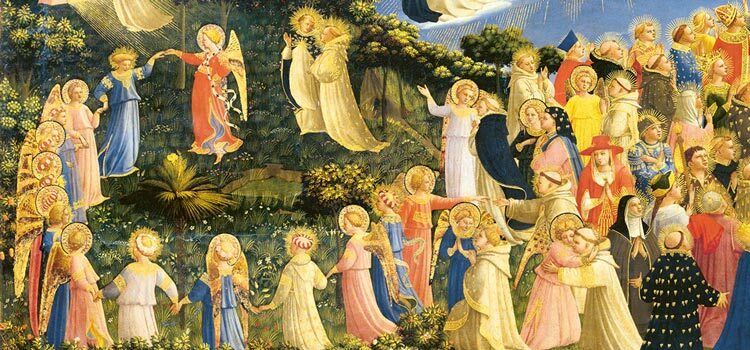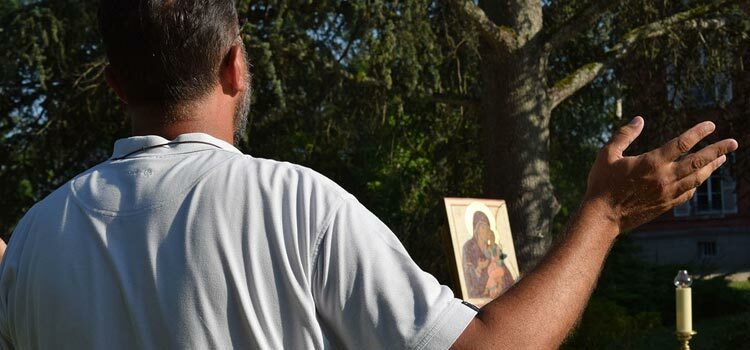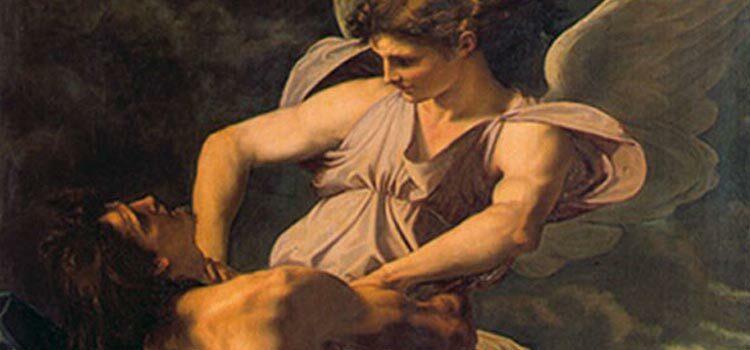The Community of the Beatitudes often refers to the Carmelite tradition, particularly on the subject of a life of orison. What does it mean? In what way is this reference important for the present world ? Without setting any limits, we could list common points between our community and the Carmelite tradition. Many of them will be examined and developed in other bulletins of « Il est là ! ».
Faithfulness to silent personal prayer: The first reason why Carmel is a reference for us, is the emphasis on a life of quiet personal prayer as a basic instrument to be united with God and be transformed from within. We have spoken about it at great length in the earlier issues…
The Marian dimension: The order of the «Brothers of Our Lady of Mont Carmel» (considered as spiritual heirs to the Prophet Elijah, which our Community also considers as an important figure) has been aware of a special bond with the Virgin Mary and of her marked protection, from the very start of its existence in the Holy Land at the end of the XII century. Ephraïm often told us that «the Community belongs to the Holy Virgin». It is the source of a great hope to us.…
The nuptial dimension of the Christian spirituality: More than other religious traditions, Carmel strongly brings out the nuptial dimension of a Christian life: each soul is called to be betrothed to God. It is a basic topic running through all the Scriptures: «Your spouse will be your Creator» (Is. 54,5). Even if we only taste N°5 –JANUARY 2019 some of the first-fruits and even if life here below is more expectation than possession of the Bridegroom, it is great to know that the aim of our humble faithfulness to prayer lies in this loving union with God, of which marriage is the most beautiful symbol.
An important feature of Therese of Avila’s thinking is the focus on Jesus’ human nature as the meeting point with the fullness of God’s mystery. Therese of Avila reacted against some mystical currents in her time, which held the view that, once a certain step of spiritual life was reached, Jesus’s humanity had no room in the union between God and man, all materialistic or sensitive reality should be overtaken…
The foundress warns us against any kind of spirituality, of an abstract nature, which would put aside Jesus’s human nature. She always remains in the logic of the Incarnation, an important point to make in our present day and age. The temptation of «disincarnation», of a rejection or going beyond the human condition, is strong today. But without the realism of the Incarnation, there is no real union with God…there could be some pride or a risk of delusion in wanting to choose another way to God outside of Christ who is the Way, the Truth and the Life, and in wishing to meet God whilst rejecting or fleeing from our human nature and its limits.
The apostolic value of a contemplative life should also be pointed out. What strongly urged Therese of Avila into reforming the Carmel, were the Church’s sufferings in her time: religious wars in Europe, discovery of new pagan people in America… orison is for her a way toward union with God and wholly an answer to the needs of her time. This apostolic intention, as we know, is very much alive in Therese of Lisieux’s thinking.
We know Therese of Avila’s words at the time of her death «I am daughter of the Church». We share this love of the Church. We acknowledge all we have received from the Church and are aware that there is no genuine spiritual life without being inserted in and serving the Church. The Community does not exist for itself but for the Church.
What is John of the Cross telling us? As well as being the best cantor of nuptial love between the soul and God, he invites us to receive the Cross as the deepest place of communion with Christ and inner transformation.
Another important feature of his teaching is the invitation to accept poverty in prayer (although these are not quite the words he uses, he speaks more of «night») Orison is essentially founded, not on our intelligence actively at work, on feelings, on imagination, but on the practice of faith, hope and love, which implies the acceptance of some darkness and poverty. Neither sensitive experiences, nor pictures, nor special knowledge (God is beyond all that) but bare faith, firm hope, pure love lead to a contact with God. This involves accepting poverty, some kind of «night»: to believe is to accept to see nothing, to hope is to accept to own nothing, to love is to forget oneself…
This night is not comfortable but it protects us. Meditation (reflection on a mystery, use of imagination, and so on) is necessary and good sometimes because we need to feed our faith, our hope and our charity, but it cannot be the usual way to a daily practice of silent personal prayer for a long time. Prayer must become simple and set on becoming more receptivity than activity: a bare and poor act of faith, an attitude of humility and hope, a trusting reception of the love God has for us, and a complete surrender to this love, without trying to always feel or understand it…
This path in bare faith, hope and love, is important in our world. Firstly, because we need simplicity, in a life which is often very overcrowded and complicated. Secondly, because we are overwhelmed with feelings, informations, pictures, too greedy for ownership, too keen on finding security, on success or human contentment, even in spiritual life. This prayer of poverty achieves a purification regarding all that and detaches us from everything that is not God but only a way toward him.
Another topic of the Carmelite tradition is the discovery of God’s presence in oneself. There are some very beautiful excerpts on this topic in Therese of Avila, John of the Cross and of course Elisabeth of the Trinity. It is all about recollection and inner life. The topic is too rich to be tackled here but it will be necessary to come back to it since it is absolutely essential.
A basic reason to our link with Carmel, lies of course in the «little way of Thérèse of Lisieux». Undoubtedly, she is the best interpreter of John of the Cross for us today, and gives the clearest description of the path to holiness we are called to follow, which amounts to this: «It is enough to acknowledge one’s nothingness and to surrender oneself like a child in the Good God’s arms» (Letter 226)…
Citation
«I know a spring which gushes and flows, but it is in the depth of the night, this spring of living water, aim of my desire, in this true bread of Life, I see it, I contemplate it, but it is in the depth of the night». St. John of the Cross
| «Therefore, since we are surrounded by so great a cloud of witnesses, let us also lay aside every weight and sin which cling so closely, and let us run with perseverance the race that is set before us.» (Heb.12,1) For me, what is most important in the Carmelite tradition today, is the fact that it is a school of spiritual freedom. Indeed, we contemplate in, «a cloud of witnesses» such as Thérèse, John, Elisabeth and so many others’, what freedom is and the immense prospects we are marked out for. But one has to receive freedom. In Carmel, we receive a wisdom which frees our heart from its narrowness, from everything in it which is not love. What is more, the road to freedom is rough and we find in Carmel some friends who help us to go on with stamina. Thus received Carmel becomes one of the instruments God uses to make the new name which will be ours forever to come about in us (cf. Ap 2,17).
Frère Marie-Laurent Huet, o.c.d. |
To Go Further…Just for today
Books
|






